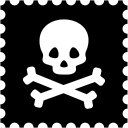How I Started A $3.5K/Month Handmade Bag Company
Note: This business is no longer running. It was started in 2016 and ended in 2023. Reason for closure: Change business name as "Jen Fox Studios".
Hello! Who are you and what business did you start?
I'm Jen, and I own FOXLY Handmade, a handmade bag company based in Albuquerque, New Mexico. I work with artists to develop illustrations that I then turn into useful, practical pouches. Think of them as little pieces of portable, functional art!
It took me a few years to find the ONE product that I really connected with, that my customers responded to, and that I could scale. After a few years of trying it all, I landed on my signature line of zipper pouches, which I have been selling exclusively since the beginning of 2019. I love being able to collaborate with and support other artists and share their valuable work more broadly with my audience.
After several years of selling almost entirely at pop-up shops and in-person events, I pivoted to focus on eCommerce sales of my pouches on my own website in late 2019. And boy, am I glad I did - my timing was just right to get my feet under me before all of my 2020 events were canceled.
Now, I've transitioned my business almost entirely online, and my website sales have been growing month over month. I anticipate that I will triple last year's sales by the end of this year, even...

Download the report and join our email newsletter packed with business ideas and money-making opportunities, backed by real-life case studies.

Download the report and join our email newsletter packed with business ideas and money-making opportunities, backed by real-life case studies.

Download the report and join our email newsletter packed with business ideas and money-making opportunities, backed by real-life case studies.

Download the report and join our email newsletter packed with business ideas and money-making opportunities, backed by real-life case studies.

Download the report and join our email newsletter packed with business ideas and money-making opportunities, backed by real-life case studies.

Download the report and join our email newsletter packed with business ideas and money-making opportunities, backed by real-life case studies.

Download the report and join our email newsletter packed with business ideas and money-making opportunities, backed by real-life case studies.

Download the report and join our email newsletter packed with business ideas and money-making opportunities, backed by real-life case studies.




























